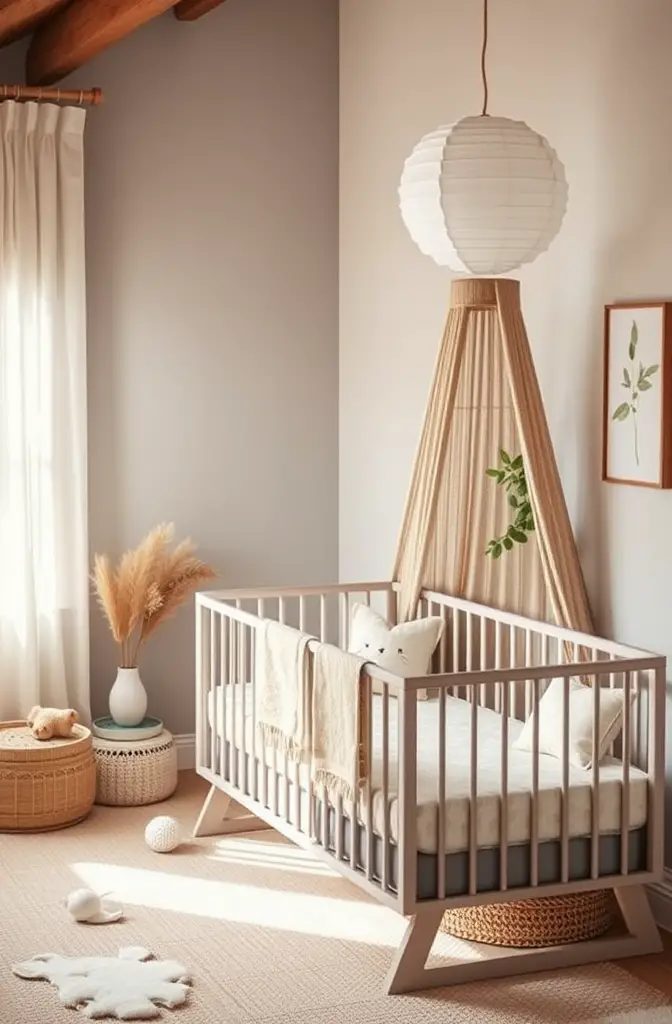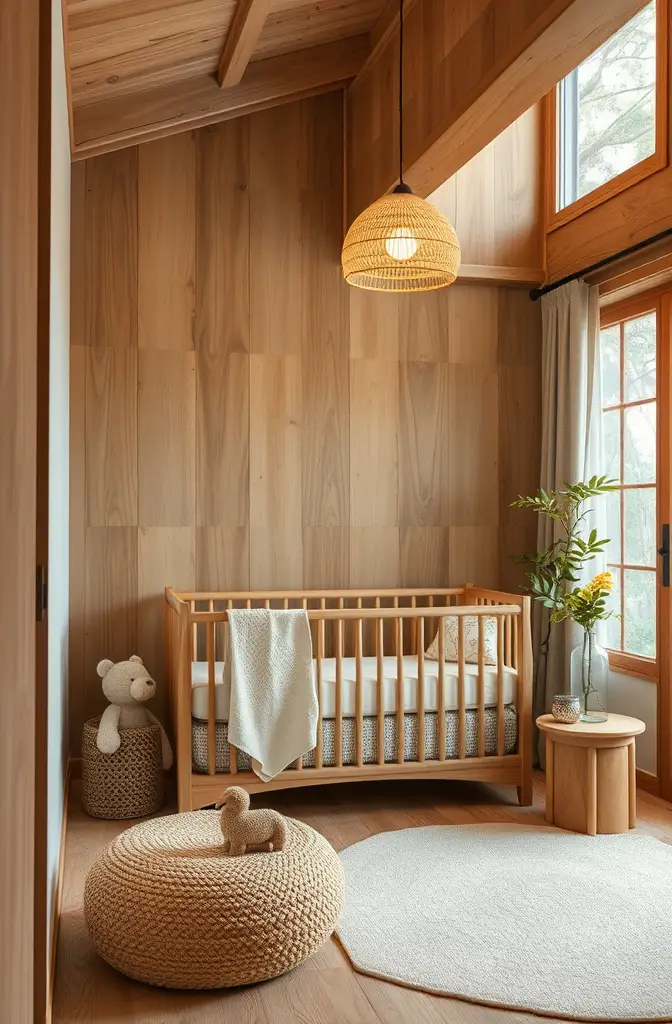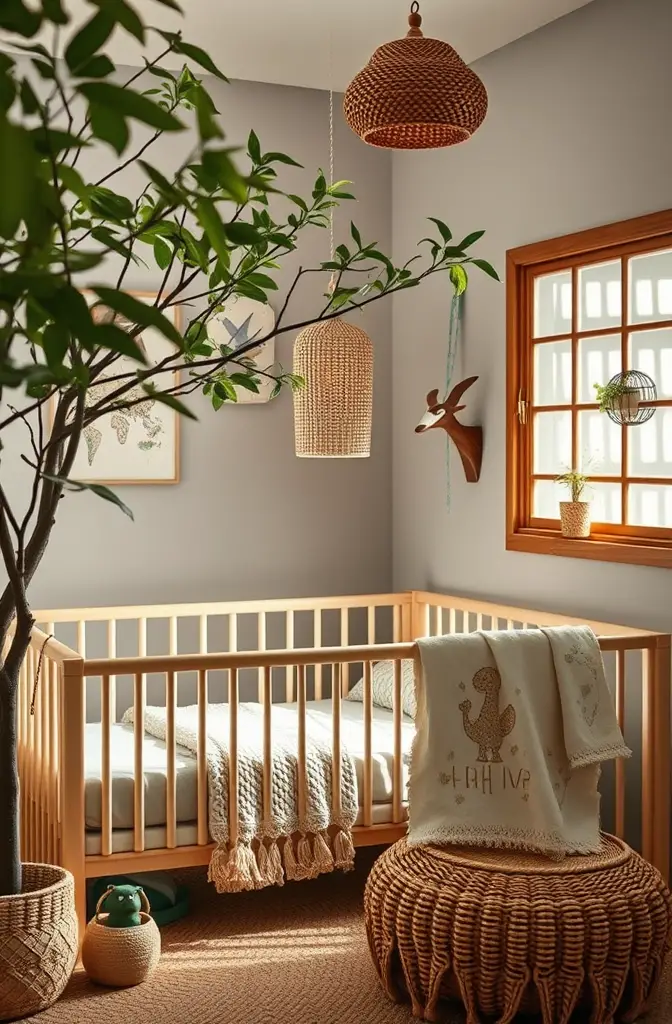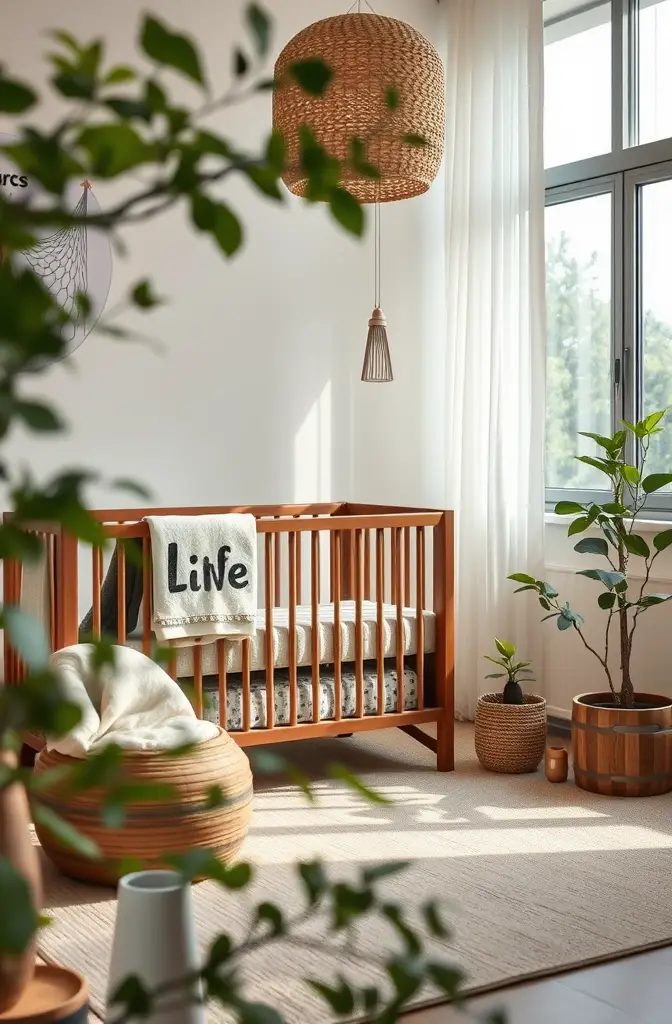I discovered Japandi design when helping my sister create her baby’s nursery, and it was a total game-changer.
The clean lines, natural materials, and peaceful vibe perfectly balanced both function and beauty—exactly what every new parent needs.
If you’re looking to create a nursery that feels both modern and timeless, these Japandi-inspired ideas will help you design a space that grows beautifully with your child while keeping that sense of calm we all crave.
✨Click to Get My 101 FREE Designer Room Ideas
Neutral Color Palette with Earthy Pops


The foundation of any Japandi nursery starts with a soothing, neutral color palette that creates instant calm.
Think soft creams, gentle beiges, warm taupes, and muted grays as your base colors.
Unlike purely Scandinavian spaces that might lean into bright whites, Japandi embraces warmer neutrals that feel more grounded and cozy.
To prevent the space from feeling flat or boring, incorporate earthy accent colors like rust, terracotta, moss green, or muted navy blue in small, intentional doses.

These nature-inspired pops of color can appear in crib sheets, a single wall hanging, or a handcrafted wooden toy collection.
The beauty of this approach is how it creates a soothing backdrop for your baby’s developing visual senses without overwhelming them with too much stimulation.
For the walls, consider natural clay paints that add subtle texture while keeping the space feeling organic and breathable.
When selecting fabrics, opt for natural materials in these neutral tones—linen curtains in oatmeal, a wool rug in soft gray, or cotton bedding in gentle ecru.
The color palette should feel cohesive but not perfectly matched, mimicking the natural variation found in nature.
Remember that shadows and light become design elements in Japandi spaces, so the neutrals will shift beautifully throughout the day, creating a dynamic yet peaceful environment.
Consider adding just one statement piece in a bolder version of your accent color—perhaps a rust-colored rocking chair or a deep navy storage bench that anchors the space while maintaining the overall tranquility.
Natural Wood Elements With Character


In a Japandi nursery, wood isn’t just a material—it’s the soul of the space, bringing warmth and natural beauty to even the most minimal design.
Opt for furniture pieces that showcase natural grain patterns and honest construction rather than painted or highly processed finishes.
A solid wood crib with simple, architectural lines becomes not just functional but a stunning centerpiece that will patina beautifully over the years.
Look for woods with warm undertones like white oak, walnut, or cherry that feel substantial without being heavy or imposing in the space.
Incorporate different wood tones throughout the room rather than matching everything perfectly—this creates depth and interest while maintaining the organic feel essential to Japandi design.
Consider a statement wall of wood slats or panels that adds texture and warmth while serving as a beautiful backdrop for the crib or changing station.
Wooden toys displayed on open shelving become both playthings and decorative elements that align perfectly with the aesthetic.
For storage, look for handcrafted wooden boxes or bins with simple designs rather than plastic alternatives—they’ll last longer and bring that tactile natural element to everyday items.
A wooden mobile above the crib featuring simple geometric shapes provides visual interest while maintaining the calm, natural vibe of the space.
Don’t forget smaller wood touches like picture frames, wall hooks, or even a wooden sound machine that blend function with beauty.
If you’re feeling adventurous, consider incorporating the Japanese technique of Shou Sugi Ban—charred wood—for a dramatic accent piece like a floating shelf or small side table.
The contrast between the blackened wood and lighter elements creates beautiful tension in the space without disrupting the overall harmony.
Minimalist Furniture With Thoughtful Details


Japandi nursery furniture strikes that perfect balance between form and function, with pieces that serve clear purposes while adding visual interest through subtle details.
The crib should feature clean lines and minimal ornamentation, perhaps with slightly tapered legs or carefully rounded corners that nod to both Japanese and Scandinavian design traditions.
Rather than cluttering the room with furniture, select each piece intentionally—a sleek dresser that doubles as a changing table, a comfortable chair with a small footprint, and perhaps one accent piece like a bench or small bookshelf.
Look for furniture that sits slightly elevated off the floor, creating a sense of lightness and making the room feel more spacious (plus making it easier to clean underneath).
Hardware should be minimal or absent entirely, with drawers and doors that open smoothly through clever design rather than prominent handles or knobs.
Consider a rocking chair or glider with a lower profile than traditional nursery chairs—something with a smaller silhouette but excellent lumbar support for those late-night feeding sessions.
Built-in storage solutions that blend seamlessly with walls help maintain the clutter-free aesthetic while providing practical space for all the baby essentials.
Avoid furniture with excessive details or decorative elements—instead, let the quality of materials and the precision of construction be the features that stand out.
If budget allows, invest in handcrafted pieces from artisans who specialize in woodworking—these pieces become heirlooms that tell a story beyond the nursery years.
For the ultimate in space efficiency, explore furniture that transforms or serves multiple functions, like a crib that converts to a toddler bed or wall-mounted shelving that can be reconfigured as your child grows.
Don’t forget to consider proportion—in Japandi design, the relationship between objects matters as much as the objects themselves, so ensure furniture pieces complement rather than compete with each other.
Soft Textiles With Natural Textures


Textiles are where the Japandi nursery truly comes alive, softening the clean architectural lines with layers of comforting texture that invite touch and create coziness.
Opt for exclusively natural fibers—organic cotton, linen, wool, and hemp—that feel substantial against the skin and improve with age and washing.
Layer different weights and weaves to create visual and tactile interest: a chunky knit throw draped over the rocker, a lightweight linen canopy floating above the crib, and a medium-weight cotton rug underfoot.
For window treatments, choose simple linen panels that filter light beautifully rather than blocking it completely, creating that soft, diffused glow that makes Japandi spaces feel so serene.
Consider investing in a handwoven wall hanging that incorporates natural fibers and subtle pattern—this adds dimension to walls without the business of wallpaper or painted designs.
Crib bedding should be simple but thoughtfully selected—perhaps a fitted sheet in the softest organic cotton and a lightweight muslin swaddle rather than elaborate bedding sets with unnecessary components.
Look for textiles with subtle texture variations rather than bold patterns—think: linen with visible slubs, cotton with a gentle waffle weave, or wool with natural color variations.
Reserve any patterns for small applications like a single pillow or storage basket, keeping them geometric or nature-inspired with low contrast between colors.
Incorporate traditional Japanese textile techniques like shibori (indigo dyeing) or sashiko (decorative stitching) in small doses through a throw pillow or wall hanging.
Don’t forget the practical aspects—include washable slipcovers for the nursing chair and consider performance fabrics for areas likely to face spills and spit-up situations.
The layering of textiles should feel intentional but not overly styled—this is where the Scandinavian concept of “hygge” (coziness) meets Japanese “wabi-sabi” (finding beauty in imperfection).
✨Click to Get My 101 FREE Designer Room Ideas
Statement Lighting That Creates Atmosphere


In a Japandi nursery, lighting does much more than illuminate—it sculpts the space, creates mood, and serves as functional art that elevates the entire design.
Instead of traditional nursery lighting with characters or overly childish designs, opt for pendant lights with clean lines and natural materials like paper, bamboo, or woven rattan.
A show-stopping paper lantern pendant that nods to Japanese design tradition can become the room’s focal point while diffusing light beautifully for a gentle glow.
Layer your lighting with at least three sources: ambient light from an architectural fixture, task lighting near the changing area and reading nook, and accent lighting to highlight special features or create atmosphere.
Consider wall sconces with articulating arms that can be adjusted as your needs change, from bright light for diaper changes to dimmed light for bedtime routines.
A floor lamp with a minimal profile and warm-toned shade provides essential lighting for nighttime feedings without disturbing your baby’s sleep with harsh overhead light.
Look for fixtures with natural materials that complement the wood tones in your furniture—perhaps a pendant with a wooden canopy or a table lamp with a ceramic base in earthy tones.
Smart lighting features like dimmers are essential in a nursery, allowing you to gradually decrease brightness during bedtime routines and maintain minimal illumination for middle-of-the-night check-ins.
For a truly authentic touch, incorporate traditional Japanese lighting elements like a shoji-inspired floor lamp or a simple lantern-style table lamp that casts beautiful shadows.
Pay attention to the quality of light as well as the fixtures themselves—warm-toned LED bulbs (2700-3000K color temperature) create a much more soothing environment than cool-toned lighting.
Consider a simple projection night light that casts subtle star patterns on the ceiling rather than character-themed versions—the gentle movement and soft light create a meditative atmosphere perfect for settling a fussy baby.
Biophilic Elements That Connect to Nature


Bringing elements of nature indoors is fundamental to Japandi design, creating a nursery that feels grounded, alive, and connected to the natural world outside your windows.
Start with child-safe houseplants that purify air and add life to the space—sturdy options like ZZ plants, bird’s nest ferns, or spider plants thrive with minimal care while staying non-toxic.
If maintaining live plants feels overwhelming with a newborn, high-quality silk plants or preserved botanicals can provide the biophilic effect without the maintenance requirements.
Consider a small indoor water feature with gentle bubbling sounds that provides white noise while connecting to the Japanese appreciation for water elements in design.
Natural materials should extend beyond furniture to smaller details—stone coasters, clay pots, wooden frames, and woven baskets all reinforce the connection to the earth.
Create a nature-inspired mobile using dried botanicals, wooden beads, or fabric leaves suspended from a simple wooden hoop above the crib for visual interest that moves gently in the air.
Wall art depicting abstracted landscapes, botanical illustrations, or subtle nature photographs maintains the biophilic connection while staying true to the minimal aesthetic.
Position the crib near a window (safely away from cords) where your baby can watch leaves dance in the breeze or observe changing light patterns throughout the day.
Incorporate natural scents through essential oil diffusers (used sparingly and safely) with gentle aromas like hinoki (Japanese cypress) or lavender that create a subtle sensory experience.
Consider seasonality in your biophilic elements—branches with spring blossoms, summer grasses in a simple vase, autumn leaves in a shallow bowl, or winter evergreens can rotate through the space.
The Japanese concept of “shakkei” or borrowed scenery can be incorporated by positioning furniture to frame views of outdoor greenery, creating a seamless connection between the nursery and the natural world.
Functional Storage That Disappears Into Design


Storage solutions in a Japandi nursery should handle the inevitable accumulation of baby gear while maintaining the clean, intentional aesthetic that defines this style.
Opt for closed storage for most items—simple dressers with push-to-open drawers, floating cabinets, or built-ins with minimal hardware keep visual clutter at bay while providing ample space for clothes, diapers, and supplies.
For the items you do display, curate thoughtfully—a few special books, handcrafted toys, or meaningful keepsakes arranged with intentional negative space around them.
Utilize the vertical space with wall-mounted shelving systems that can be reconfigured as your storage needs change throughout your child’s development.
Consider furniture with hidden storage functions—an ottoman that opens for blanket storage, a bench with compartments for toys, or a side table with discrete drawers.
Woven baskets in natural materials like seagrass, water hyacinth, or bamboo add texture while corralling smaller items like stuffed animals, blocks, or textile items.
Install simple wall hooks at varying heights—lower ones your child can eventually reach themselves and higher ones for items you want to keep out of reach.
Look for under-crib storage solutions that utilize that often-wasted space without disrupting the clean lines of the room—simple canvas drawers or wooden trays on wheels work beautifully.
Create designated zones for different categories of items—sleeping necessities near the crib, feeding supplies near the nursing chair, and daily care items at the changing station.
Embrace the Marie Kondo-inspired aspect of Japandi philosophy by regularly editing and purging items that no longer serve a purpose or bring joy to the space.
Remember that negative space is a design element in itself—resist the urge to fill every drawer and shelf to capacity, allowing room for your storage needs to grow and change.
Handcrafted Accents With Artistic Merit


Handmade elements elevate a Japandi nursery from simply stylish to deeply meaningful, incorporating pieces with soul and story that machine-made items simply can’t match.
Seek out artisan-created furniture pieces where you can see the hand of the maker—a hand-carved wooden stool, a ceramic lamp base with subtle irregularities, or a nursing chair upholstered by a craftsperson.
Wall art should lean toward handcrafted techniques like block printing, shibori dyeing, calligraphy, or simple line drawings rather than mass-produced prints.
Incorporate one statement textile piece like a hand-loomed blanket, a quilted wall hanging, or a macramé mobile that showcases traditional techniques with contemporary design.
For toy selection, prioritize handcrafted wooden toys, fabric dolls, or natural material blocks that double as display-worthy objects when not in active play.
Consider commissioning a special piece from a local artisan specifically for the nursery—perhaps a wooden name sign, a ceramic nightlight, or a custom mobile that becomes an heirloom.
Look for ceramics with wabi-sabi characteristics—subtle asymmetry, visible texture, and earthy glazes—for plant pots, small storage vessels, or decorative objects.
A handwoven basket for storing blankets or toys adds rich texture while honoring traditional crafting techniques central to both Japanese and Scandinavian design traditions.
For a personal touch, frame simple art created by family members—your own botanical sketch, a sibling’s painting, or handwritten words of wisdom from grandparents.
Seek out children’s books illustrated with traditional Japanese techniques like sumi-e (ink wash painting) or Scandinavian woodblock prints that align with the aesthetic while expanding your child’s visual literacy.
Remember that handcrafted doesn’t have to mean rustic—many contemporary artisans create pieces with clean lines and minimal aesthetics that perfectly complement Japandi style.
✨Click to Get My 101 FREE Designer Room Ideas
Intentional Negative Space For Visual Calm


Perhaps the most distinctive feature of Japandi nursery design is what isn’t there—the deliberate empty space that allows the eye and mind to rest, creating a sense of peace essential in a baby’s environment.
The Japanese concept of “ma” (間)—the meaningful pause between elements—should guide your placement of furniture, allowing each piece to be appreciated individually rather than crowding the room.
Wall décor should be minimal and intentional, with large expanses of uninterrupted wall space that create a sense of openness and allow architectural features to shine.
Consider the viewlines from different positions in the room—what you see while feeding, from the doorway, or when standing at the crib—and ensure each perspective offers visual breathing room.
Rather than filling shelves completely, display fewer items with space around each one, allowing them to become focal points rather than contributors to visual noise.
In a Japandi nursery, aim for furniture to occupy no more than 60% of the available floor space, preserving open areas for movement, play, and growth.
The white space in your design isn’t “empty”—it’s purposeful and contributes as much to the room’s function and feeling as the objects themselves.
As you make design decisions, continuously ask yourself: “Does this addition serve a purpose or bring joy?” If not, the negative space might be more valuable than the object.
Create at least one completely unadorned moment in the room—perhaps a simple wall with nothing on it or a corner with just a single potted plant—as a visual palette cleanser.
Resist the cultural pressure to fill every inch of a nursery with stimulation and entertainment—babies benefit enormously from spaces that allow their developing senses appropriate rest.
The minimalism of your negative space creates a beautiful backdrop for the most important element in the nursery: your baby, whose presence and development become the room’s true focal point.
Sensory Elements With Subtle Stimulation

While Japandi design embraces minimalism, a baby’s developing brain needs appropriate sensory input—the key is providing thoughtful stimulation that doesn’t overwhelm or disrupt the calm aesthetic.
Incorporate varied textures that invite touch exploration—a nubby wool rug, smooth wooden toys, soft linen curtains, and rough ceramic planters provide diverse tactile experiences.
Consider acoustic elements that create a peaceful soundscape—a small fountain with gentle water sounds, wind chimes outside the window, or a quality sound machine with natural white noise options.
Add subtle scent elements through natural materials rather than artificial fragrances—hinoki wood (Japanese cypress), cedar accents, or beeswax candles (kept safely away from the baby) provide gentle olfactory stimulation.
Visual stimulation should come from natural variations in materials rather than bright colors—the grain patterns in wood, the weave of textiles, or the organic shapes of plants provide complexity without chaos.
Create a simple sensory mobile using natural materials in muted tones—wooden rings, ceramic beads, or fabric scraps in different textures suspended above the changing table provide entertainment during diaper changes.
Consider a light projector that casts subtle patterns of moving light on the ceiling during evening hours—stars, gentle waves, or abstract shapes provide visual interest that isn’t overstimulating.
A small, unobtrusive music player to stream gentle instrumental music—traditional Japanese koto music or Scandinavian piano compositions align perfectly with the Japandi aesthetic.
Position the crib where your baby can observe natural light patterns throughout the day—the movement of dappled sunlight through curtains creates fascinating visual stimulation that changes naturally.
Include a basket of carefully selected sensory toys made from natural materials—wooden rattles, silk scarves, crinkle paper made from sustainable materials, or simple instruments that produce gentle sounds.
Remember that your interaction is the most important sensory element—a minimal environment allows your voice, touch, and presence to become the central focus rather than competing with a chaotic background.
Sustainable and Eco-Conscious Choices


A truly authentic Japandi nursery extends beyond aesthetics to embrace the environmental consciousness that’s fundamental to both Japanese and Scandinavian design philosophies.
Choose furniture made from sustainably harvested woods certified by the Forest Stewardship Council (FSC) or reclaimed timber that brings character while reducing demand for new materials.
Seek out zero-VOC paints and finishes for all surfaces to ensure your baby’s air quality isn’t compromised by off-gassing chemicals—many companies now offer beautiful clay and milk paints in perfect Japandi palettes.
For textiles, prioritize organic certification for items that come in close contact with your baby’s skin—GOTS-certified (Global Organic Textile Standard) cotton and linen ensure ethical production and chemical-free processing.
Consider the complete lifecycle of each item you bring into the nursery—will it biodegrade naturally, can it be passed down through generations, or can it be repurposed when no longer needed?
Embrace the “less but better” philosophy by investing in fewer, higher-quality pieces that won’t need frequent replacement, reducing consumption and waste over time.
Look for multifunctional furniture that adapts to your growing child—convertible cribs, dressers that work beyond the nursery years, and storage systems that reconfigure as needs change.
Incorporate vintage or secondhand elements where appropriate—a carefully restored wooden rocker, hand-me-down books, or antique wooden toys bring character while extending the life of existing items.
Choose energy-efficient lighting with LED bulbs and smart features that allow you to minimize electricity usage while maintaining the perfect ambiance for different activities.
Consider renewable energy sources for powering the nursery—a small solar charger for monitor batteries or window placement that maximizes natural light can reduce your carbon footprint.
The sustainability ethos should extend to the smallest details—wooden teethers instead of plastic, cloth wipes rather than disposables, and glass bottles in place of their plastic counterparts whenever possible.
Cultural Elements With Modern Interpretation


Incorporating authentic cultural touchpoints from both Japanese and Scandinavian traditions creates depth and meaning in your Japandi nursery without veering into appropriative territory.
Consider a contemporary interpretation of a traditional Japanese futon as a floor play mat—a quilted cotton pad that provides comfortable space for tummy time while nodding to Japanese floor-based living.
Integrate Scandinavian folklore through subtle motifs in textiles or wall art—simplified representations of forest animals or abstract nature symbols connect to Nordic storytelling traditions.
A shoji-inspired room divider or sliding panel system can create functional separation in a shared room while referencing traditional Japanese architecture in a respectful, contemporary way.
Look for children’s books that authentically share Japanese and Scandinavian stories and traditions, building cultural appreciation from the earliest years.
Incorporate the Scandinavian concept of “friluftsliv” (open-air living) by creating a strong connection to outdoor spaces—perhaps a window seat where you can observe nature with your baby.
Consider a modern take on traditional Japanese joinery in furniture pieces—visible dowels, butterfly joints, or other wood-joining techniques that showcase craftsmanship without fasteners.
A contemporary interpretation of sashiko embroidery on a simple pillow or wall hanging brings subtle pattern and cultural reference without feeling like a caricature.
Embrace the cultural value of craftsmanship by seeking out pieces made with traditional techniques but updated designs—hand-turned wooden rattles or hand-woven baskets with clean, modern lines.
The Scandinavian tradition of using candles to create “hygge” can be safely adapted with LED flameless candles that create the same warm, cozy atmosphere during evening routines.
Consider incorporating the Japanese concept of “ikigai” (life purpose) by creating a small display area for objects that represent your hopes and values for your child’s future.
✨Click to Get My 101 FREE Designer Room Ideas
Adaptable Design That Grows With Your Child

Perhaps the most sustainable and practical aspect of Japandi nursery design is its inherent adaptability—creating a space that evolves gracefully from newborn days through the toddler years and beyond.
Start with a quality convertible crib that transforms from bassinet to crib to toddler bed and eventually to a full-sized headboard, providing continuity through multiple developmental stages.
Choose a changing table that functions as a standard dresser once diapering days are done—simply remove the changing tray to instantly transform the piece.
Install adjustable shelving systems that can start at adult height for displaying delicate objects, then lower to become accessible book and toy storage as your child grows more independent.
Select art and décor that isn’t explicitly “babyish”—botanical prints, nature photography, or abstract textile art will remain relevant and appealing well beyond the infant years.
Incorporate a growth chart that doubles as an artistic wall feature—perhaps a simple wooden board with minimalist markings or a linen hanging with subtle measurement indicators.
Consider furniture arrangements that create natural zones for different activities, allowing the room to transition from nursing-focused to play-centered to eventually support homework and independent activities.
Invest in lighting that adapts to changing needs—fixtures on dimmer switches, adjustable reading lights, and layered lighting options work for midnight feedings and bedtime stories alike.
Choose bedding in timeless designs rather than age-specific patterns, allowing you to simply add or subtract layers rather than completely replacing sets as your child grows.
Plan for furniture that can be easily rearranged as priorities shift—from maximizing floor space for crawling to creating nooks for independent play and eventually study areas.
Remember that the Japandi philosophy of intentional simplicity creates the perfect framework for adaptation—when you’ve chosen quality pieces with clean lines and natural materials, they naturally evolve with your child’s changing needs and tastes.

